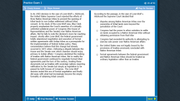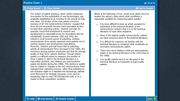I actually think note-taking is ESSENTIAL to RC, BUT the kind of notes you should be taking have NOTHING to do with the details in the passage. You might read a passage with 4 dense paragraphs and only see 1 "Detail" question accompany that passage, so why waste your time trying to understand the dozens of details present in the passage?
Knowing the "Details" will not help you answer most of the questions!!
The major RC question-types are:
-Main Idea
-Inference
-Detail
-Function
This is what is required by these questions:
-knowing the purpose of the entire passage
-knowing the author's point of view
-knowing the function of every paragraph and how the parts add up to the whole
-knowing what the passage literally says about 1-2 details
The last thing is something we can DEFINITELY go back for, so don't worry about the details as you read!
Read for STRUCTURE and what is underneath the words. Summarization is "surface-level" reading, NOT active reading.
For example, here's a short passage and how my notes would look on it:
Behavior science courses should be gaining prominence in business
school curricula. Recent theoretical work convincingly shows why behav-
ioral factors such as organizational culture and employee relations are
among the few remaining sources of sustainable competitive advantage in
modern organizations. Furthermore, (10) empirical evidence demonstrates
clear linkages between human resource (HR) practices based in
the behavioral sciences and various aspects of a firm's financial success.
Additionally, some of the world's most successful organizations have made
unique HR practices a core element of their overall business strategies.
Yet the behavior sciences are struggling for credibility in many
business schools. Surveys show that business students often regard
behavioral studies as peripheral to the mainstream business curriculum.
This perception can be explained by the fact that business students, hoping
to increase their attractiveness to prospective employers, are highly
sensitive to business norms and practices, and current business
practices have generally been moving away from an emphasis on
understanding human behavior and toward more mechanistic organiza-
tional models. Furthermore, the status of HR professionals within
organizations tends to be lower than that of other executives.
Students' perceptions would matter less if business schools
were not increasingly dependent on external funding-form legislatures,
businesses, and private foundations- for survival. Concerned with their
institutions' ability to attract funding, administrators are increasingly tar-
getting low-enrollment courses and degree programs for elimination.
Topic: Behavior science
Scope: challenges facing B.s.
Author's Pov: It should be gaining prominence. +
Paragraph 1: to state that B.s. should be gaining prominence and give 2 reasons
Paragraph 2: to add a 3rd reason
Paragraph 3 : to give 2 reasons why B.s. is struggling
Paragraph 4: to add a 3rd reason why B.s. is struggling
Purpose: to explain why B.s. should be prominent & explain challenges it faces
---
Here's how it would help us answer these two questions:
Question #1: The primary purpose of the passage is to
A. propose a particular change to business school curricula
B. characterize students' perceptions of business school curricula
C. predict the consequences of a particular change in business school curricula
D. challenge one explanation for the failure to adopt a particular change in business school curricula
E. identify factors that have affected the prestige of a particular field in business school curricular
Question #2: The author of the passage mentions "empirical evidence" primarily in order to
A. question the value of certain commonly used HR practices
B. illustrate a point about the methodology behind recent theoretical work in the behavioral sciences
C. support a claim about the importance that business schools should place on courses in the behavioral sciences
D. draw a distinction between two different factors that affect the financial success of a business
E. explain how the behavioral sciences have shaped HR practices in some business organizations
--
EXPLANATIONS
Since the first question is a "primary purpose" question, we must especially make sure to eliminate answer choices that ARE in the passage, but are not "primary" as well as choices that are outside the scope of the author's focus.
A. Out of Scope. The curricula itself is not the focus.
B. Misused Detail. While this is mentioned in the passage, it isn't the overall purpose.
C. Incorrect. The "consequences" are not specifically mentioned, nor are particular changes described.
D. Incorrect. The author does not challenge one explanation - he offers a variety of reasons why B.s is not getting its due, but does not "challenge" any of them, or suggest one carries more weight than the others and even if you interpreted it to refer to the 2nd paragraph, this would not be the focus of the ENTIRE passage.
E. CORRECT! The passage focuses on why B.s. is being challenged.
For the second question, this is a Function question. When a question asks WHY the author uses one aspect of the paragraph, go back and review the function of the ENTIRE paragraph. After all, don't details all serve to support the main goal of their containing paragraphs?
We could re-word the question as, "WHY does the author use "empirical evidence?" To make a prediction, all we need to do is return to our notes. We said that he used it as an example of why B.s SHOULD be gaining prominence. Now that we have our prediction, the answer is clearly (C).






















